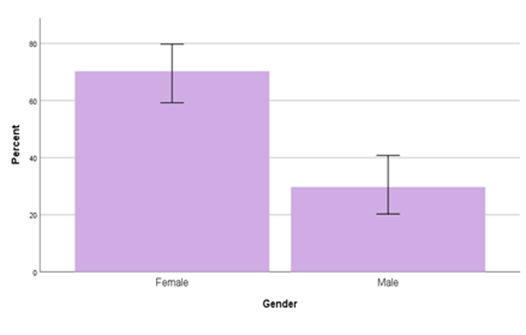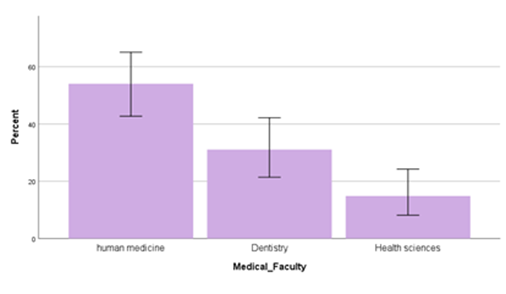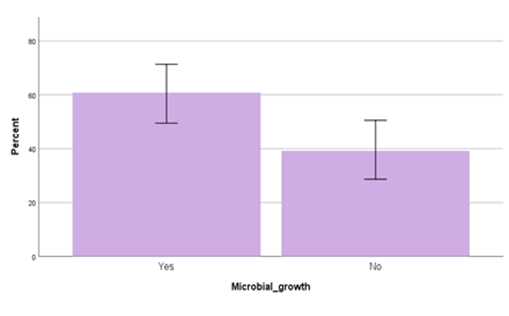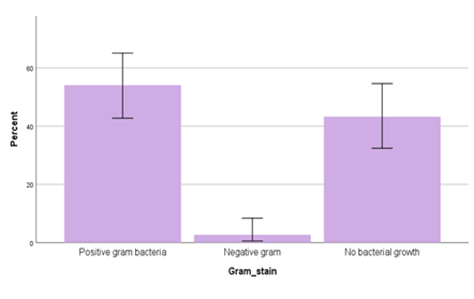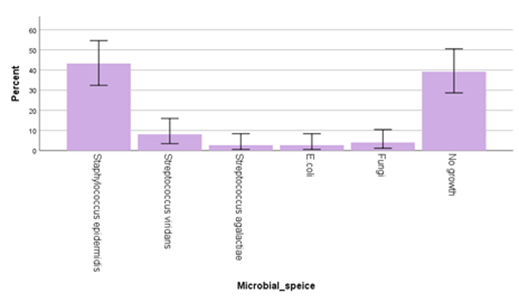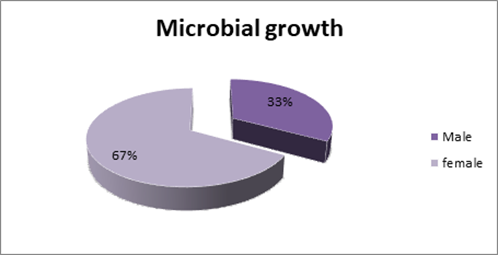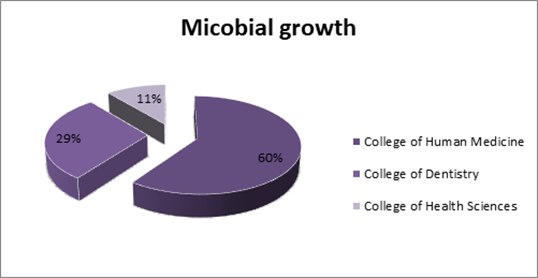Research Article
Prevalence and Risks of Mobile Phone Microbial Contamination Among Medical, Dental, and Health Sciences Students in The Healthcare Setting
- Aishe Abdulhafeid Miftah Algmati 1
- Abdalmawla Alhussin Ali 2*
- Safa Sasi Mohammed 3
- Samia Jebril Iqdoura 3
- Salma Salem Ahmoda 3
- Shahed Ali Abualgasam 3
- Shaima Kamis Ali 3
- Sumaya Maklof Younis 3
- Moftah Amhamad Abulobaida 3
- Zakia Ramadan Salem 3
1Lecturer at Laboratories Department, Faculty of Health Science, Sirte University, Libya.
2Professor (Assistant) at Orthodontic Department, Faculty of Dentistry, Sirte University, Libya.
3Graduated from Laboratories Department, Faculty of Health Science, Sirte University, Libya.
*Corresponding Author: Abdalmawla Alhussin Ali, Professor (Assistant) at Orthodontic Department, Faculty of Dentistry, Sirte University, Libya.
Citation: A.A.M. Algmati, Abdalmawla A. Ali, Safa S. Mohammed, Samia J. Iqdoura, Salma S. Ahmoda, et al. (2024). Prevalence and Risks of Mobile Phone Microbial Contamination Among Medical, Dental, and Health Sciences Students in The Healthcare Setting, International Journal of Biomedical and Clinical Research, BioRes Scientia Publishers. 1(4):1-8. DOI: 10.59657/2997-6103.brs.24.024
Copyright: © 2024 Abdalmawla Alhussin Ali, this is an open-access article distributed under the terms of the Creative Commons Attribution License, which permits unrestricted use, distribution, and reproduction in any medium, provided the original author and source are credited.
Received: July 12, 2024 | Accepted: August 26, 2024 | Published: September 02, 2024
Abstract
Introduction: Cellular phones are usually used in both the individual and professional life. They are used in healthcare centers without limits, irrespective of their unknown infectious load, and thus cellular phones can serve as a container of infection in hospitals.
Aim: The present study aimed to identify microbial pollution of medical faculty students’ s cellular phones and identify the microbial species found on the exteriors of their phones in order to take the necessary precautions.
Materials and Methods: 74 students from the medical faculties of Sirte University whom training in Ibn sina Educational Hospital and Dental Educational Clinic participant in the present study. A cross sectional study was accomplished during May to July 2023. A questionnaire was presented to all participants to collect the data. The swab samples were taken from mobile phones of all participants. The samples were then directly transmitted to the microbiology laboratory of Ibn Sina Educational Hospital, for cultured to identify the microbial contamination. Each sample was cultured on two different culture media (Blood and MacConky agar) and it incubated at 37 ℃ for 24 hours. Isolates were recognized on base of standard microbiology methods using gram stain pigmentation, colony morphology, catalase test, coagulase test in additional novobiocin test, Optochin test and bacitracin test.
Results: our findings reported that the microbial growth on mobile phones is 45(60.8%). The major proportion of growth bacteria is Gram-positive 43 (96%). While 2(4%) of growth bacteria are Gram-negative. We observed the greatest percentage of microbial species are Staphylococcus epidermidis 39(72%), then Streptococcus viridans 6(11%), fungi 5(9%), Streptococcus agalactiae 2(4%), Escherichia coli, 2(4%).
Conclusion: The current study indicated that cellular phones are one of the most important means to transmitting infection in the community and hospitals. However, with proper use of disinfectants and proper hand hygiene practices it can be reduced.
Keywords: cross-contamination; infection control; doctor and patient safety; mobile phone; microbial contamination; medical students; dental students; health sciences students; healthcare setting
Introduction
Cellular phones are a vital device for communication and are used in all aspects of life. Medical students and healthcare workers (HCWs) use phones to communicate quickly and easily within hospitals. Mobile phones can help to reduce the time it takes to communicate important messages, which can help to prevent medical errors. Moreover, the development of mobile communication has given rise to improvements in the management of many medical conditions (Soto, R. G et al., 2006). But they are infrequently cleaned and are usually contacted through or next investigation of patients and dealing of samples wanting appropriate hand lotion. Therefore, cellular phones have become an external exporter of contagion, not just for patients in hospitals, but too for possible health risks for staffs and family members (Kilic, I. H et al., 2009).
The constant usage of the cellular phone by healthcare professional exposures it to a collection of microbes and creates it adequate transporter for microorganisms, specifically those related with the epidermis, causing in the extent of various microbes from the worker (Ekrakene et al.,2009). The phones that utilized by medical students can performance as transportation carriages for pathogenic and nonpathogenic organisms together (Zakia, S., et al, 2016). Never the less an own cellular phone is an often-touched instrument in hospitals, but it is not regularly included in routine cleaning schedules. It can be polluted by resistant nosocomial pathogens and healthcare staffs use it through patient investigation. Previous studies also validate occurrences of infective diseases are more in those individuals who utilize polluted cellular phones. Though most private things are retained in changing rooms, cellular phones habitually accompany the staff into the operating theatre, critical care unit and wards where calls are made or replied whereas interest patients (Selim and Abaza, 2015).
Hand sanitation is confirmed for avoidance of hospital acquired infections and it is easy to application in developing countries where properties are restricted. Yet, the probable extent of illnesses by polluted instruments or other articles that are not deemed in routine cleaning programs is often connived, and they are a possible exporter of microorganisms in the hospitals, Gowns, gloves, bedside stethoscopes, neck ties, bed barriers, sheets, phones, flat surfaces, door knobs, thermometers, nurse’s clothing and own bags are polluted via pathogenic bacteria (Heyba et al., 2015). The hands and gloves of healthcare staffs facilely gain the pathogens after touch with polluted hospital surfaces and apparatus, and then transmit these organisms to then contacted patients (Collins AS., 2008). Around 80,000 to 180,000 infections could be avoided annually (Gastmeier et al.,2010), specially via sufficient hand cleanliness and increased intensity of cellular phones cleaning (Tannhäuser et al.,2022). The aim of the present study is to inspect the microbial pollution of cellular phones of medical collages students and to identify the microbial species found on the surfaces of their phones.
Materials and Methods
Study Population and Methodology
74 students from the medical faculties of Sirte University (Human medicine, Dental medicine and Health sciences) who training in Ibn sina Educational Hospital and Dental Educational Clinic participant in the present study. This a cross sectional study was achieved during May to July 2023. A questionnaire was presented to all participants to collect the data (Appendix.1). So as to prohibit cross-contamination, the data collectors were utilized an alcohol-based sanitizer to disinfect their hands before wiping each cellular phone. The swab samples were taken from cellular phones of all participants by wiping the front, back and edges of their phones using a sterile cotton swab which soaked with sterile distil water. The samples were then directly transferred to the microbiology laboratory of IbnSina Educational Hospital, for cultured to identify the microbial contamination. Each sample was cultured on two different culture media (Blood and MacConky agar) and it incubated at 37°C for 24 hours. Isolates were recognized on base of standard microbiology methods using gram stain pigmentation, colony morphology, catalase test, coagulase test in an additional novobiocin test and optochin test and bacitracin test.
Ethical Consent
Oral agreement was secured from all participants and they filled the questionnaire of this study.
Statistical Analysis of Data
The qualitative data was presented as frequency and percentage.
Results
Distribution of the Study Sample According to Gender
74 students from medical faculty of Sirte University participant in this study. We observe that the major proportion of the participants is female 52(70%), while male participants are 22(30%) as shows (Figure 1).
Figure 1: Distribution of the study sample according to gender.
Distribution of the study sample according to the faculty
Figure 2, ILLUSTRATED the participants according to Medical Faculty. 41 students (55.41%) are from the Faculty of Human Medicine, and 22 (29.73%), 11(14.86%) students from the Faculty of Dentistry and Oral Surgery, Faculty of Health Sciences respectively.
Figure 2: Distribution of the study sample according to the medical faculty.
Distribution of the study sample according to microbial growth on cellular phones
After culture the swabs, we observe the microbial growth are presence on 45(60.8%) phones. Whereas, 29(39.2%) phones are not presence the microbial growth on them as shows (Figure 3).
Figure 3: Distribution of the study sample according to microbial growth on cellular phones.
Distribution of the growth bacteria according to Gram stain
According to Gram stain, Figure 4 shows the major proportion of growth bacteria is Gram-positive 43 (96%). While 2(4%) of growth bacteria are Gram-negative.
Figure 4: Distribution of the growth bacteria according to Gram stain.
Distribution of the study sample according to microbial species
Figure 5 illustrates the microbial species that isolated from student’s mobile phones whom training in health facilities. We observed the greatest percentage of microbial species are Staphylococcus epidermidis 39(72%), then Streptococcus viridans 6(11%), fungi 5(9%), Streptococcus agalactiae 2(4%), Escherichia coli, 2(4%).
Figure 5: Distribution of the study sample according to microbial species.
Distribution of microbial growth according to gender
According to the gender of students, we observe that the largest percentage of microbial growth is on female’s phones 30 (67%), while the percentage of microbial growth on male’s phone is 15 (33%) as shown as (Figure 6).
Figure 6: Distribution of microbial growth according to gender.
Distribution of microbial growth according to medical faculty
Figure 7 illustrates that the highest percentage of presence the microbial growth on phones is among students of Human Medicine Faculty 27(60%). While, 13(29%), 5(11%) on phones of students from the Faculty of Dentistry and Oral Surgery, Faculty of Health Sciences respectively.
Figure 7: Distribution of microbial growth according to medical faculty.
Distribution of microbial growth according to department
Table 1 shows the highest proportion of isolated microbial from cellular phones of medical students whom training in Gynecology department 11(24.44%), then 10(22.22%) in conservation treatment department, 6(13.33%) in Ophthalmology and Internal medicine departments, 3(6.66%) in medical laboratories department, 2(4.44%) in X-ray, ICU, Diagnosis and Conservation treatment departments,1(2.22%) in Pediatric, Surgery and Medical examination departments.
Table 1: Distribution of the presence of microbial growth according to department.
| Presence Of Microbial Growth in Department | Frequency | Percentage |
| Medical Lab | 3 | 6.66% |
| X-Ray | 2 | 4.44% |
| Gynecology | 11 | 24.44% |
| Ophthalmology | 6 | 13.33% |
| Pediatric | 1 | 2.22% |
| Internal Medicine | 6 | 13.33% |
| ICU | 2 | 4.44% |
| Surgery | 1 | 2.22% |
| Diagnosis | 2 | 4.44% |
| Medical Examination | 1 | 2.22% |
| Conservation Treatment | 10 | 22.22% |
| Total | 45 | 100% |
Discussion
This study aimed to determine the bacterial contamination of cellular phones among students of the medical faculties whom training in healthcare settings Sirte city. The healthcare setting environment plays a critical role in the transmission of organisms associated with nosocomial infections. Microorganisms can be transmitted from one person to another or from inanimate objects (such as stethoscopes, bronchoscopes, pagers, ballpoint pens, hospital patient charts, computer keyboards, mobile phones, and landline telephones) to the hands and vice versa (Goldblatt et al., 2007, Ferrer-Roca et al., 2004, Ali AA, 2018). In this study, we found that the prevalence of organisms on medical students' mobile phones was (60.8%) in contrast to another study in Nigeria, where high contamination rates (80.6%) were reported by Amala et al., 2015) and in study that conducted by Zakai et al., 2015 reported the percentage of bacterial contamination on the tested cell phones was 96.2%.
Cellular phones used by medical students in hospital departments that may be contaminated with bacterial pathogens. The results of this study suggest that cellular phones are carry the pathogenic bacteria, including Gram-positive and Gram-negative bacteria that can spread mononucleosis. The present study showed a high level of contamination with Gram-positive bacteria 43 (96%) and lower with Gram-negative bacteria 2 (4%).
In study conducted by Domenico et al.,2020, they reported that Staphylococci were present in 85% of cellular phones, Enterococci in 37%, Coliforms in 6.5%; E. coli was never detected. Staphylococcus epidermidis was the most frequently isolated staphylococcal species (72%). Our finding agree with this study in Staphylococcus epidermidis was the most frequently isolated staphylococcal species from our samples (70%), but the Escherichia coli was detected in the present study (4%). Study published in Iraq by Needham M 2020. For Bacterial contamination associated with cellular phones used by students were reported Staphylococcus aureus 27.7%, Staphylococcus epidermidis 20.4%, Pseudomonas aeruginosa 17.6 %, Escherichia coli 12.1% and fungi 1.9% were the most frequently identified microorganisms. In this study, several Microorganisms were isolated, Staphylococcus epidermidis 39(72%), followed Streptococcus viridans 6(11%), fungi 5(9%), Streptococcus agalactiae 2(4%), Escherichia coli, 2(4%).
In our study fungal contamination of students’ cellular phones was found in (9%), this finding is lower than in contrast to, other studies. In the study by Kurli et al., 2018, fungi were found in 29%. Similar findings were reported from a study from Japan with contamination of 31.7% (Furuhata, K. et al., 2016), and a Nigerian study that revealed 30.6% contamination of university students’ cellular phones (Akinyemi et al., 2009).
Conclusion
Cellular phones are usually used almost everywhere in society and in healthcare environments. Our results mention that these phones used by medical students could assist to transmit the pathogenic and non-pathogenic organisms. Therefore, we recommend introducing training programs at an early stage in medical schools on intensive infection prevention and control in hospitals, increasing awareness of hand hygiene and regular cleaning of cellular phones, to reduce the risk of cross-contamination by these devices in healthcare settings.
References
- Akinyemi, K. O., Atapu, A. D., Adetona, O. O., Coker, A. O. (2009). The Potential Role of Mobile Phones in The Spread of Bacterial Infections. The Journal of Infection in Developing Countries, 3(8):628-632.
Publisher | Google Scholor - Ali AA, Tarawneh AMA, Abdulqader MA. (2018). Level of Awareness of Maintaining Dental Records Among Dental Practitioners in Sirte: Are We Ready for Forensic Odontology? J Dents Dent Med. 1(2):102.
Publisher | Google Scholor - Amala, S. E., Ejikema, I. F. (2015). Bacteria Associated with the Mobile Phones of Medical Personnel. American Journal of Biomedical Sciences, 7(1).
Publisher | Google Scholor - Brady, R. R., Verran, J., Damani, N. N., Gibb, A. P. (2009). Review of Mobile Communication Devices as Potential Reservoirs of Nosocomial Pathogens. Journal of Hospital Infection, 71(4):295-300.
Publisher | Google Scholor - Collins, P. L., Graham, B. S. (2008). Viral and Host Factors in Human Respiratory Syncytial Virus Pathogenesis. Journal of Virology, 82(5):2040-2055.
Publisher | Google Scholor - Corrin, T., Lin, J., MacNaughton, C., Mahato, S., Rajendiran, A. (2016). The Role of Mobile Communication Devices in The Spread of Infections Within a Clinical Setting. Environmental Health Review, 59(2):63-70.
Publisher | Google Scholor - Costa, P., Graveto, J., Santos, C., Fernandes, E., Albano, H., et al. (2018). Methicillin-Resistant Staphylococcus Aureus Spreading Through Medical Devices Used in Nursing Care: What Can We Learn from Portugal? International Journal of Infectious Diseases, 73:292-293.
Publisher | Google Scholor - Cremers-Pijpers, S., Van Rossum, C., Dautzenberg, M., Wertheim, H., Tostmann, A., et al. (2021). Disinfecting Handheld Electronic Devices With UV-C In a Healthcare Setting. Infection Prevention in Practice, 3(2):100133.
Publisher | Google Scholor - Ekrakene, T., Iloba, B. (2014). Re-Colonization of Soil Micro Arthropods From 5cm Depth Within 5 Months Period of Treatment with Endosulfan (Organochlorine Pesticide) Treatment in Benin City, Nigeria. Nigerian Journal of Life Sciences, 4(1):58-66.
Publisher | Google Scholor - Ferrer-Roca, O., Cardenas, A., Diaz-Cardama, A., Pulido, P. (2004). Mobile Phone Text Messaging in The Management of Diabetes. Journal Of Telemedicine and Telecare, 10(5):282-285.
Publisher | Google Scholor - Furuhata, K., Ishizaki, N., Sogawa, K., Kawakami, Y., Lee, S. I., et al. (2016). Isolation, Identification and Antibacterial Susceptibility of Staphylococcus Spp. Associated with The Mobile Phones of University Students. Biocontrol Science, 21(2):91-98.
Publisher | Google Scholor - Goldblatt, J. G., Krief, I., Klonsky, T., Haller, D., Milloul, V., et al. (2007). Use Of Cellular Telephones and Transmission of Pathogens by Medical Staff In New York And Israel. Infection Control & Hospital Epidemiology, 28(4):500-503.
Publisher | Google Scholor - Hessling, M., Haag, R., Sicks, B. (2021). Review of Microbial Touchscreen Contamination for The Determination of Reasonable Ultraviolet Disinfection Doses. GMS Hygiene and Infection Control, 16.
Publisher | Google Scholor - Heyba, M., Ismaiel, M., Alotaibi, A., Mahmoud, M., Baqer, et al. (2015). Microbiological Contamination of Mobile Phones of Clinicians in Intensive Care Units and Neonatal Care Units in Public Hospitals in Kuwait. BMC Infectious Diseases, 15(1):1-9.
Publisher | Google Scholor - Hirsch, E. B., Raux, B. R., Lancaster, J. W., Mann, R. L., Leonard, S. N. (2014). Surface Microbiology of The IPAD Tablet Computer and The Potential to Serve as A Fomite in Both Inpatient Practice Settings as Well as Outside of The Hospital Environment. PLoS One, 9(10):e111250.
Publisher | Google Scholor - Jamalludeen, N. M. (2020). Bacterial Contamination Associated with Mobile Phones Used by Students at Basrah Medical College, Basrah, Iraq. The Medical Journal of Basrah University, 38(1):58-66.
Publisher | Google Scholor - Kayed, K., Khoder, G., Farhat, J., Ghemrawi, R. (2023). Mobile Phones: Reservoirs of Resistant Bacteria During The COVID-19 Pandemic in Abu Dhabi, United Arab Emirates. Microorganisms, 11(2):523.
Publisher | Google Scholor - Kilic, I. H., Ozaslan, M., Karagoz, I. D., Zer, Y., Davutoglu, V. (2009). The Microbial Colonisation of Mobile Phone Used by Healthcare Staffs. Pakistan Journal of Biological Sciences, 12(11):882-884.
Publisher | Google Scholor - Kurli, R., Chaudhari, D., Pansare, A. N., Khairnar, M., Shouche, Y. S., et al. (2018). Cultivable Microbial Diversity Associated with Cellular Phones. Frontiers in Microbiology, 9:1229.
Publisher | Google Scholor - Manning, M. L., Davis, J., Sparnon, E., Ballard, R. M. (2013). Ipads, Droids, And Bugs: Infection Prevention for Mobile Handheld Devices at The Point of Care. American Journal of Infection Control, 41(11):1073-1076.
Publisher | Google Scholor - Hikmah N', Anuar TS. (2020). Mobile Phones: A Possible Vehicle of Bacterial Transmission in a Higher Learning Institution in Malaysia. Malays J Med Sci. 27(2):151-158.
Publisher | Google Scholor - Messina, G., Quercioli, C., Burgassi, S., Nisticò, F., Lupoli, A., et al. (2011). How Many Bacteria Live on The Keyboard of Your Computer? American Journal of Infection Control, 39(7):616-618.
Publisher | Google Scholor - Sriprapun M, Atthakorn O, Phuakwilai A. (2022). The Prevalence of Bacterial Contamination on Mobile Phones of Pharmacy University Students, Pharmaceutical Sciences Asia. 49(4):356-363.
Publisher | Google Scholor - Meyer, E., Schwab, F., Schroeren-Boersch, B., Gastmeier, P. (2010). Dramatic Increase of Third-Generation Cephalosporin-Resistant E-Coli in German Intensive Care Units: Secular Trends in Antibiotic Drug Use and Bacterial Resistance, 2001 to 2008. Critical Care, 14:1-9.
Publisher | Google Scholor - Mushabati, N. A., Samutela, M. T., Yamba, K., Ngulube, J., Nakazwe, R., et al. (2021). Bacterial Contamination of Mobile Phones of Healthcare Workers at The University Teaching Hospital, Lusaka, Zambia. Infection Prevention in Practice, 3(2):100126.
Publisher | Google Scholor - Omran A, Taha MS. (2020). Bacterial Contamination of Mobile Phones Among Health Care Workers: A Meta-Analysis Study. J Med Sci Res. 3:87-94.
Publisher | Google Scholor - Ong, E., Wong, M. U., Huffman, A., He, Y. (2020). COVID-19 Coronavirus Vaccine Design Using Reverse Vaccinology and Machine Learning. Frontiers in Immunology, 11:1581.
Publisher | Google Scholor - Nwankwo, E. O., Ekwunife, N., Mofolorunsho, K. C. (2014). Nosocomial Pathogens Associated with The Mobile Phones of Healthcare Workers in A Hospital in Anyigba, Kogi State, Nigeria. Journal Of Epidemiology and Global Health, 4(2):135-140.
Publisher | Google Scholor - Qureshi, N. Q., Mufarrih, S. H., Irfan, S., Rashid, R. H., Zubairi, A. J., et al. (2020). Mobile Phones in The Orthopedic Operating Room: Microbial Colonization and Antimicrobial Resistance. World Journal of Orthopedics, 11(5):252.
Publisher | Google Scholor - Sadeeq, T., Arikan, A., Sanlidag, T., Guler, E., Suer, K. (2021). Big Concern for Public Health: Microbial Contamination of Mobile Phones. The Journal of Infection in Developing Countries, 15(6):798-804.
Publisher | Google Scholor - Selim, H. S., Abaza, A. F. (2015). Microbial Contamination of Mobile Phones in A Health Care Setting in Alexandria, Egypt. GMS Hygiene and Infection Control, 10.
Publisher | Google Scholor - Shaikh, A., Gangrade, H., Agrawal, N., Bhori, M., Singh, K. (2018). Preliminary Investigation on Repurposing of NSAIDs By Assessing Cytotoxic Effect on Hepatic Cell Line. Innovations in Food, Environment and Healthcare, 102.
Publisher | Google Scholor - Simmonds, R., Lee, D., Hayhurst, E. (2020). Mobile Phones as Fomites for Potential Pathogens in Hospitals: Microbiome Analysis Reveals Hidden Contaminants. Journal of Hospital Infection, 104(2):207-213.
Publisher | Google Scholor - Soto, R. G., Chu, L. F., Goldman, J. M., Rampil, I. J., Ruskin, K. J. (2006). Communication In Critical Care Environments: Mobile Telephones Improve Patient Care. Anesthesia & Analgesia, 102(2):535-541.
Publisher | Google Scholor - Tannhäuser, R., Nickel, O., Lindner, M., Bethge, A., Wolf, J., et al. (2022). Bacterial Contamination of The Smartphones of Healthcare Workers in A German Tertiary-Care Hospital Before and During The COVID-19 Pandemic. American Journal of Infection Control, 50(4):414-419.
Publisher | Google Scholor - Vinall, K., Hellmich, E. A. (2021). Down The Rabbit Hole: Machine Translation, Metaphor, And Instructor Identity and Agency. Second Language Research & Practice, 2(1):99118.
Publisher | Google Scholor - Zakai, S., Mashat, A., Abumohssin, A., Samarkandi, A., Almaghrabi, B., et al. (2016). Bacterial Contamination of Cell Phones of Medical Students at King Abdulaziz University, Jeddah, Saudi Arabia. Journal of Microscopy and Ultrastructure, 4(3):143-146.
Publisher | Google Scholor

